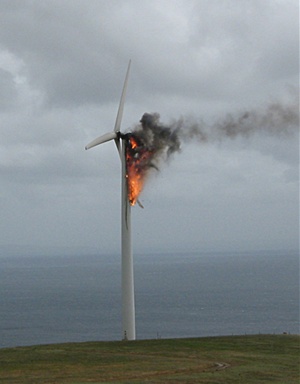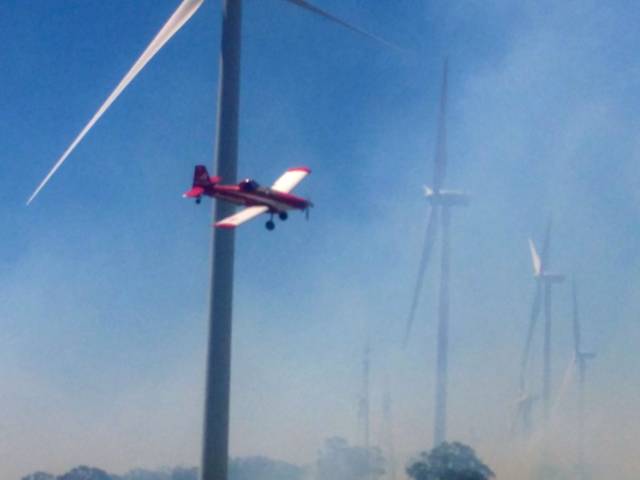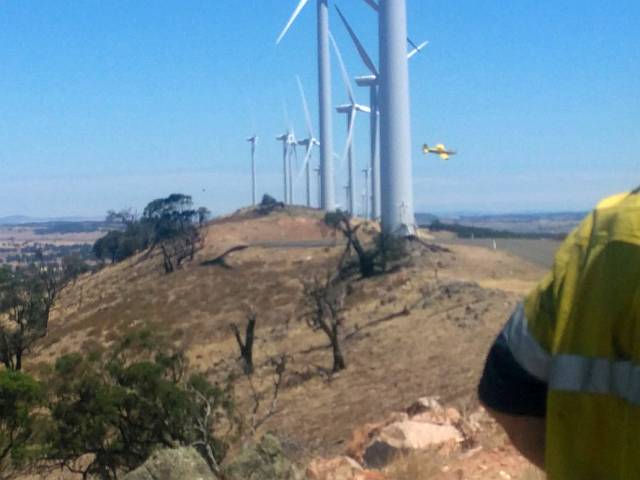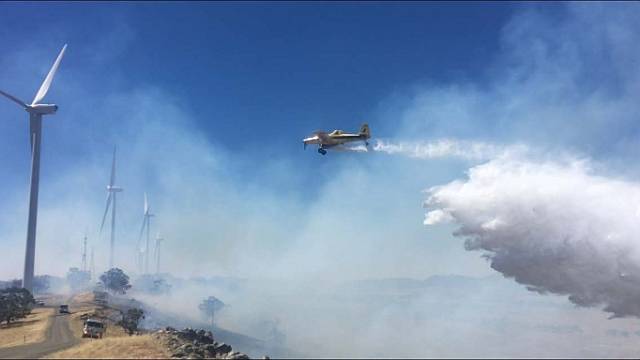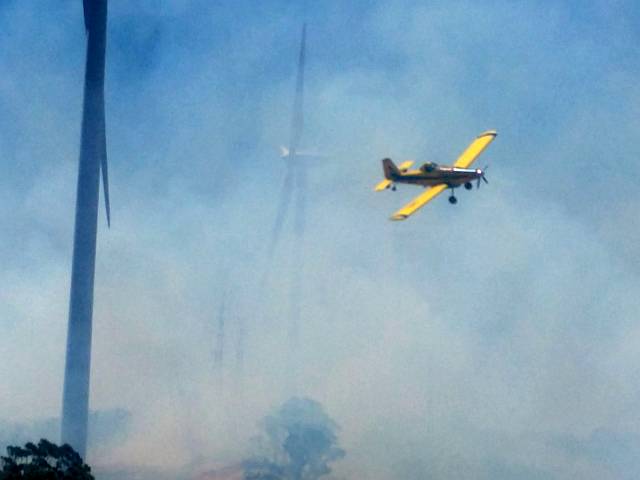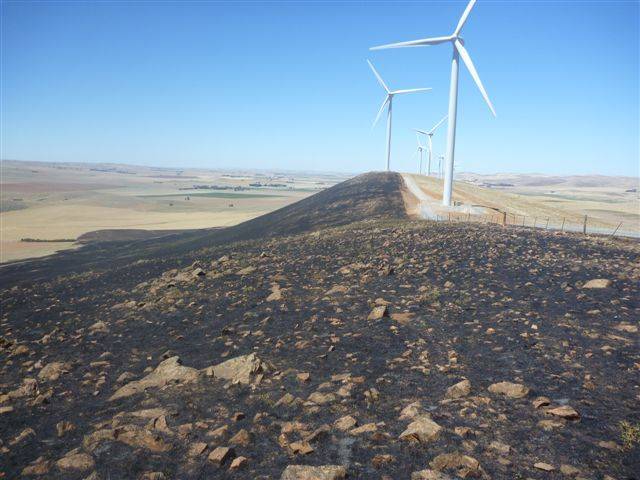Introduction
|
It needs to be said that it is quite likely that the frequency of bushfires will be reduced by the presence of wind turbines. Wind turbines on the tops of ridges will safely conduct many lightning strikes to earth, while, before the turbines were built, the lightning strikes may well have started fires. Lightning strikes are a very common cause of wild fires in Australia.
The area around the base of all turbines is kept clear of vegetation (in the case of the proposed Mount Bryan Wind Farm at least, the SA Country Fire Service required a cleared area of 40m × 40m), but a fire in the nacelle, on top of the tower, could result in sparks and burning material falling on the ground at a distance from the tower.
Geoff Conway of the Country Fire Authority has said that fires from agricultural machinery at harvest are a far greater fire risk than are wind turbines.
|
|
Some turbines have built-in fire suppression facilities such as automatic
flooding with carbon dioxide.
This is not used on Suzlon turbines in Australia because of the risk of
asphyxiation of workers; protecting life is held more important than
protecting assets.
|
Much is made by wind turbine opponents of the 300 litres of oil in the turbine gearbox being a fire hazard. This would be true if the fire was due to failure of the gearbox, but I had the piece below from Brendan Ryan of Suzlon:
"I worked for Vestas when one of their turbines burned at Lake Bonney. I remember clearly the inspection crew had checked the inside of the gearbox and found no signs of heat damage even though the whole external nacelle was destroyed."Brendan also told me that all their turbines have carbon dioxide extinguishers in the nacelle and at the bottom of the turbine.
A claim on the frequency of wind turbine fires
This shows how irresponsible journalists and people ideologically opposed to wind power can latch onto even a very poorly written report to spread the fallacies that suit them. The report involved was "Overview of Problems and Solutions in Fire Protection Engineering of Wind Turbines".
|
|
Very little of what I've written here is opinion; almost everything can be confirmed by referring to the Uadiale et al report, to the sources it references and in only one case, an article on the Internet by Business Spectator.
Uadiale et al referred back to The Telegraph newspaper and to Caithness Windfarm Information Forum (CWIF) and Wind Action, both the latter being anti-wind power organisations, as authoritative sources. This is highly questionable in a science paper.
|
|
Unjustified conclusion
On the fourth page of the report the authors go from the observation that:"The newspaper The Telegraph reported that there were about 1500 wind turbine accidents in the UK between 2006 and 2010 while only about a tenth as many were recorded by the anti-wind power organisation CWIF."to the unjustified conclusion that:
"Thus we can argue that the publicly available tip of the iceberg represents about 10% of the total number of [wind turbine] fires"
|
This completely unjustified conclusion has been gleefully taken up and repeated world-wide by unscrupulous anti-wind power organisations.
Of course, unlike work-place accidents on wind farm sites, wind turbine fires are highly conspicuous and almost invariably will be reported by the local media.
Dishonest
In the case of a turbine fire at Lake Bonney Wind Farm, Australia, there were also dishonest specific claims in Uadiale et al.- The report stated that "some 80,000 ha of national park were destroyed by a wildfire ignited by the turbine debris" and gave an Australian Broadcasting Commission report as a reference. In fact, the ABC Net site referred to mentions a blaze that "consumed more than 70 hectares" and did not mention wind turbines at all; it was referring to another fire that happened four years after the turbine fire.
- Uadiale et al stated that "Investigation into the cause of the fire found that the cause was an electrical failure within the turbine nacelle" while the referenced source stated "We don't know the cause of it at this stage because we can't get at it, but it's probably an electrical fault in the turbine".
- Uadiale et al claimed that "The incident led to the shutdown of the farm, leaving some 63,000 homes without electricity". In support of this claim Uadiale et al referred to an anti-wind power Net site called Wind Action. The Wind Action page referred to actually stated that it was a "heatwave [that] left 63,000 South Australian homes without power".
|
Points 1 and 3 above seems later to have been used in the Discussion and Conclusions section of the report where it was stated that:
"These fires result in financial loss, power loss (which is especially problematic in remote locations where the wind turbines are a major source for electricity), as well as secondary damage, for example through road closures or ignition of wild fires in rural areas."In fact no evidence is given that a major power loss did result from a turbine fire or that there was an ignition of a wild fire.
Nonsensical
The basic claim, that turbine fires are under-reported makes no sense. What could be more conspicuous than a fire in a wind turbine? Any person nearby would likely get a photo and forward it to a local newspaper. All the country newspapers that I know of would jump at the chance to report on a local wind turbine fire, especially when there was a photo involved.So far as I know there have been three turbine fires (that destroyed the turbines involved) here in Australia up to the time of writing, July 2014. All were well publicised. It is conceivable that there might have been a fourth that I have not heard about; it is utterly beyond belief that there could have been 27!
I believe that Sarah Laurie, a well known and very vocal anti-wind power activist based in South Australia, has called electrical cable joint fires, 1200mm below ground level, 'wind farm fires', so there may well be some over-reporting of wind turbine fires.
Number of fires per turbine decreasing
It is to the credit of the authors that they included this section. Quoting from page 2 of the report:"Because the absolute number of fire accidents tends to increase with the number of installed turbines, the expected growth in the installation of wind turbines, also bring the expectation of an increase in the number of turbine fires. However, the [ratio] of fire accidents per turbine installed has decreased significantly since 2002."
Author plays down the report
In an article in Wind Power Monthly, 2014/07/17, Guillermo Rein, an engineer in fire safety from Imperial College London and one of the authors of the report was quoted as saying:"In terms of fire hazard, the figures are almost negligible. It is a one in 10,000 probability of a fire. There is no scandal here. This number is not zero, but it is minimal. By comparison with other energy industries, fire accidents are much less frequent in wind turbines than other sectors, such as oil and gas, which globally has thousands of fire accidents per year."So why was he involved in producing the misleading report?
More information should be available
While the Uadiale et al report is seriously flawed, it is true that the wind power industry could be much more pro-active in making wind power statistics freely available to the public.|
|
|
Aerial fire-fighting and wind turbines
| ||||
| ||||
| ||||
|
The Waterloo fire of 2017/01/17
The following section, about the fire, was written 2017/01/20. It is as I understand the situation at the time of writing; but I expect to learn more in the coming days and weeks.The photos on the right were taken during a fire which started some kilometres to the west of Waterloo Wind Farm and burned up to the ridge where the turbines were. The turbines were paused by the wind farm operators and the water bombing aircraft flew wherever they were needed, sometimes between the turbines.
The fire was stopped at the turbine access road along the top of the ridge. However, a secondary fire was started by a wind-blown ember on the eastern side of the ridge; this burned back up to the top of the ridge.
I believe that this is the first wildfire in Australia that was at a wind farm and in which water bombing aircraft were used.
SA in particular
ABC News published the following on 2012/12/11...The Country Fire Service (CFS) says wind farms do not pose any special hazards when it comes to fighting fires from the air.
Some wind farm opponents say the turbines create unique hazards in the event of a fire.
CFS aviation manager David Pearce says the pilots of water bombers view wind farms like they would power-lines or radio masts.
"Aircraft are only used on a relative minority of fires throughout the fire season, it's just really another piece of infrastructure in the environment that we just need to be managing on a risk basis when we're fighting fires," he said.
"Any obstacle in the airspace where we're running aircraft is a problem for aircraft obviously.
"We would treat the wind farms exactly the same way as we treat powerlines that are reasonably high, also radio masts, television towers or even high structures."
Victoria in particular
ABC online news 2015/02/25 ran an article headlined: "Wind farm buffer zone changes won't impede firefighting says Victoria's Emergency Management Commissioner"Quoting the ABC article:
Victoria's Emergency Management Commissioner has rejected claims that reducing wind farm buffer zones could affect firefighting capabilities.
During the election, Labor promised to reduce the exclusion zone around new wind farm projects from two kilometres to one.
Wind Industry Reform Victoria represents people living near wind farms and said the Government's plan would make firefighting "impossible" near houses close to turbines.
However, Emergency Management Commissioner Craig Lapsley said that was not the case.
"We make sure that our pilots and our air attack supervisors that fly to supervise our fire-bombers are aware of wind farms and they build that into their plan and we haven't had any example where it's restricted our fire operations," he said.
"I think the key thing is how and which we use aircraft operation in and around the turbines."
"We have operated around turbines, we'll continue to do so and the buffer zones we don't believe will impact negatively on any fire operations."
|
|
Fire hazard without wind farms
It should be recognised that climate change, if unabated by changing from fossil fuels to renewable energy, will result in incomparably greater increases in fire hazard than any caused by wind turbines. Scientific American, June 2011, carried an article stating that fire danger in the western US states will increase up to six fold with just one degree higher average temperatures.Googling something like "fire hazard climate change" will provide many references showing that wild fires have become more intense and the fire season has become longer due to climate change, and that this is only going to get worse in the future unless the world changes to renewable energy. Just one such is by the Climate Council of Australia.
Lightning strike
A common cause of fires in Australia is lightning strike, which is covered at greater depth in another page. The risk of wild fires started by lightning strike will be significantly reduced in an area where the ridge-tops are lined with wind turbines that safely conduct the lightning to the earth.Turbine access roads are useful to fire-fighters
|
A turbine access road was again useful in fighting the Waterloo fire of 2017/01/17.
|
|
|
Fires wrongly blamed on wind turbines
As discussed on another page on this site wind farm opponents are typically dishonest. The subject of turbines and fires is no exception. To the best of my knowledge by 2019 there were about 2300 utility scale turbines in Australia, only three had caught fire and none of these had resulted in more than local spot fires resulting from falling debris.Of particular relevance to this section there has been a claim on the anti-wind-power site Stop These Things that "In Australia, wind turbines have so far been responsible for at least four serious bushfires:
- Ten Mile Lagoon in Western Australia in the mid-1990s;
- Lake Bonney, Millicent (SA) in January 2006;
- Cathedral Rocks Wind Farm, Port Lincoln (SA) in February 2009; and
- Starfish Hill (SA) in November 2010."
Lake Bonney turbine fire
As discussed elsewhere on this page a very dubious report made unsupported claims about a bushfire sparked by a turbine fire at the Lake Bonney Wind Farm. This seems to have been picked up and repeated by wind farm opponents.There is a short article about the fire, that occurred on 2006/01/22, on the ABC News site with no mention of any fire beyond the immediate vicinity.
There was also an article written by David Nankervis and published in the South Australian Sunday Mail on 2006/02/12. Nankervis's article was highly critical of wind power (as is common in the Murdoch-owned media) so there is no reason to believe that he would have minimised any damage caused by the fire.
Nankervis reported that the six fire appliances that attended the blaze couldn't do anything to extinguish the turbine fire because it was so high. He went on the say:
"Instead, the firefighters watched as fire destroyed the $3 million turbine – which weighs 75 tonnes – and extinguished spot fired ignited by ashes from the turbine blaze"
Bird causes flash-over fire
Wind turbine opponents have blamed this fire on wind turbines, but it was caused by a bird and a power line.The Sydney Morning Herald reported on a fire on 17 January 2017 at Currandooley, near Tarago in the Canberra area. It seems that the power line involved carries power between Woodlawn and Capital wind farms, both owned by Infigen.
The SMH article, by Georgina Connery, stated
"The fire started as a result of a bird flying close to high-voltage powerlines, igniting and landing in dry grass."The fire burned "almost 3400ha".
It seems that this was something of a freak event. Birds being electrocuted by going too close to a couple of high voltage power lines is apparently quite common, but to then set fire to grass is very unusual. Of course it could happen on any high voltage power line. It seems that 2017/01/17 was a very hot day.
Louise Thrower in the Goulburn Post reported Infigen's response to the event:
"It was an unusual event. We have had over 20 unplanned outages over four years prior to the recent event and we suspect bird strikes on powerlines were responsible for all of those. (But) it has caused only one fire over four years".
Starfish Hill Wind Farm turbine fire
There was a fire in one of the Starfish Hill Wind Farm turbines on the afternoon of 2010/10/30. It was written up in an article in the Victor Harbor Times on 2010/11/04, but this seems no longer to be available. The fire caused an estimated $3m damage.
This fire was reported on the anti-wind-power site Wind Watch.
Significantly there was no mention of the fire getting beyond the turbine except for a few spot fires nearby.
How frequent are wind turbine fires?
An article by Robin Whitlock written for Interesting Engineering and published 2015/11/21 stated:"Indeed, wind turbine fires are far less common than fires occurring in other energy industries, such as the oil and gas sector, in which there are thousands of fires per year. According to GCube, an insurance underwriter serving the wind industry, only three or four turbine losses per year can be attributed to turbine fire, out of a global portfolio of more than 30 gigawatts (GW). That translates into just one turbine in 7,000 catching fire per year."I have not been able to discover how many wind turbines there are in Australia in 2024 but a rough estimate would be 3,000. There were about 1600 back in 2013, so we could estimate an average of about 2,300 over the last ten years. There have been four turbine fires that I know of in the last ten years. That works out at one turbine in 6,000 catching fire per year in Australia.
On 2024/02/14 I contacted the federal department of Climate Change, Energy, the Environment and Water asking for the number of industrial scale wind turbines in Australia.
